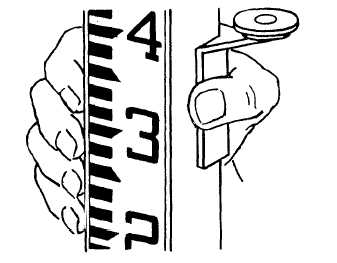instrument (H.I.) and the base of the rod. On a windy day, the rodman may have difficulty holding the rod plumb. In this case, the levelman can have the rodman wave the rod back and forth, allowing the levelman to read the lowest reading touched on the engineer's level cross hairs.
The use of a rod level ensures a vertical rod. A bull's-eye rod level is shown in figure 5-14. When it is held as shown (on a part of the rod where readings are not being taken to avoid interference with the instrumentman's view of the scale) and the bubble is centered, the rod is plumb. A vial rod level has two spirit vials, each of which is mounted on the upper edge of one of a pair of hinged metal leaves. The vial level is used like the bull's-eye level, except that two bubbles must be watched instead of one.
Care of Leveling Rods
A leveling rod is a precision instrument and must be treated as such. Most rods are made of carefully selected, kiln-dried, well-seasoned hardwood. Scale graduations and numerals on some are painted directly on the wood; however, on most reds they are painted on a metal strip attached to the wood. Unless a rod is handled at all times with great care, the painted scale will soon become scratched, dented, worn, or otherwise marked and obscured. Accurate readings on a scale in this condition are difficult.
Allowing an extended sliding-section rod to close on the run, by permitting the upper section to drop, may jar the vernier scale out of position or otherwise damage the rod. Always close an extended rod by easing the upper section down gradually.
A rod will read accurately only if it is perfectly straight. It follows, then, that anything that might bend or warp the rod must be avoided. Do not lay a rod down flat unless it is supported throughout, and never use a rod for a seat, a lever, or a pole vault. In short, never use a rod for any purpose except the one for which it is designed.
Store a rod not in use in a dry place to avoid warping and swelling caused by dampness. AI ways wipe off a wet rod before putting it away. If there is dirt on the rod, rinse it off, but do not scrub it off. If a soap solution must be used (to remove grease, for example), make it a very mild one. The use of a strong soap solution will soon cause the paint on the rod to degenerate.

Figure 5-14. - Bull's-eye rod level.
Protect a rod as much as possible against pro- longed exposure to strong sunlight. Such exposure causes paint to chalk (that is, degenerate into a chalk-like substance that flakes from the surface).
DIFFERENTIAL LEVELING
LEARNING OBJECTIVE: Upon completing this section, you should be able to determine elevations in the field to locate points at specified elevations.
The most common procedure for determining elevations in the field, or for locating points at specified elevations, is known as differential leveling. This procedure, as its name implies, is nothing more than finding the vertical difference between the known or assumed elevation of a bench mark and the elevation of the point in question. Once the difference is measured, it can (depending on the circumstances) be added to or subtracted from the bench mark elevation to determine the elevation of the new point.
ELEVATION AND REFERENCE
The elevation of any object is its vertical distance above or below an established height on the earth's surface. This established height is referred to as either a "reference plane" or "simple reference." The most commonly used reference plane for elevations is mean (or average) sea level, which has been assigned an assumed elevation of 000.0 feet. However, the reference plane for a construction project is usually the height of some permanent or semipermanent
Continue Reading